Source: Asia Wealth Investment Daily
The blockchain revolution is coming…
And it’s going to fundamentally change how businesses operate.
Make no mistake… this revolution is at least as significant as the one brought about by the Internet. It will disrupt every single business on the face of the earth.
That’s why it’s vital that you learn to understand this technology. It will offer countless investing opportunities in the years ahead… and it will play a central role in future years in how you (and, without question, your children) work, do business, play, and operate in society.
I know that sounds like a lot. But bear with me as I explain a bit…
(And, if you want to hear from two of the world’s blockchain experts about how this is going to happen – and how to invest in it – sign up for our live webinar (it’s on Wednesday night in the U.S. and Thursday morning in Asia.))
Understanding blockchain
“Blockchain” is one of those words that has the power to confuse even the smartest people. And the media is completely clueless about how this technology actually works.
For starters, blockchain is the technology behind cryptocurrencies like bitcoin.
The Bitcoin blockchain allows us to transfer the bitcoin currency person to person without any intermediary. When I transfer U.S. dollars to you, we either have to do it in person – with me handing you cash – or through the banking system, which involves me telling my bank to send money to your bank account.
(Bitcoin with a capital “B” refers to the blockchain, whereas bitcoin with a lowercase “b” refers to the cryptocurrency.)
But how does this actually work?
Think of the Bitcoin blockchain as a giant Excel spreadsheet that shows the complete transaction history and location of every bitcoin.
Every 10 minutes the spreadsheet gets updated as an additional “block” of new transactions is added to the spreadsheet.
Everyone can have their own copy of the spreadsheet. It’s completely transparent.
Let’s say Jim sends 1 bitcoin to Sally. When the transaction is processed by the blockchain, the spreadsheet is updated. Jim’s balance is decreased by a bitcoin, and Sally’s is credited one.
But who updates the spreadsheet? And how do we stop people from trying to make false updates to the spreadsheet, awarding themselves more bitcoin, or trying to send the same bitcoin to two different people at the same time?
That’s the job of what are called nodes, which are also known as miners. Nodes are the computers or large computer systems that support the Bitcoin network and keep it running smoothly. Nodes are run by individuals or groups of people who contribute money towards buying powerful computer systems, known as mining rigs.
There are two types of nodes, full nodes and lightweight nodes.
Full nodes keep a complete copy of the blockchain (i.e., the giant Excel spreadsheet). This is a record of every single transaction that has ever occurred. This is currently around 150 gigabytes in size. (For reference, the largest USB thumb drives usually max out at about 128 gigabytes.)
Lightweight nodes, on the other hand, only download a fraction of the blockchain. Lightweight nodes are used by most folks for bitcoin transactions. A lightweight node will communicate to a full node when it wants to transact.
So the full nodes (or miners) run the spreadsheet, but how do they keep the spreadsheet synchronised between them all? This is the key, considering there’s no limit to the number of people who can run their own full node.
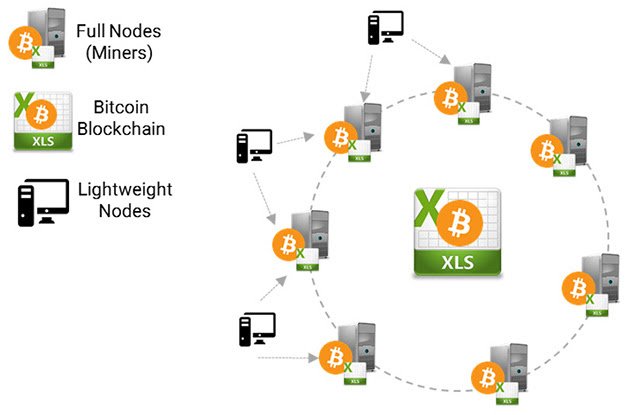
How do nodes process transactions?
Let’s go back to Jim and Sally. Jim wants to send 1 bitcoin to Sally.
Sally creates a bitcoin wallet. Anyone can create a bitcoin wallet in a couple of minutes. When you create your wallet, there are two pieces of information created for you:
Your public key: Also known as a public address, or your bitcoin address. It’s a string of numbers and letters. Think of it like an account user name.
Your private key: This is effectively your bitcoin password, and you need to keep it safe. If you lose it, it means you lose access to your bitcoin. (There’s no centralised entity that can recover your password for you – it’s not like if you forget your Facebook password and you have email instructions sent to you to reset it.) – and if someone else gets it, they can take your bitcoin.
Sally tells Jim her public key. Jim opens his bitcoin wallet, puts in the instruction to send 1 bitcoin to Sally’s public address, enters in his private key (password) to authorise the transaction and hits send.
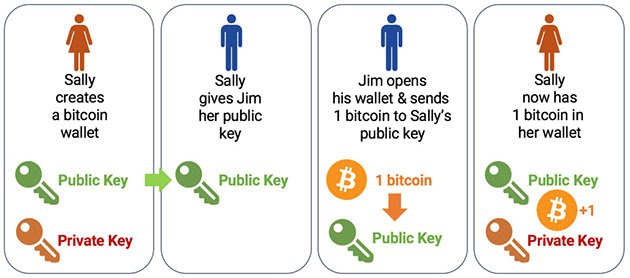
After a few minutes, Sally checks her wallet again, and sees she now has a bitcoin in her wallet. But what’s happening behind the scenes?
First, the network (in this case a lightweight node) makes a quick check of the proposed transaction. It checks to see that Jim has enough bitcoin in his account. And it checks if the address Sally provided is a valid bitcoin address.
After the transaction passes those two tests, the transaction gets bundled together with other pending transactions into a “block”.
That block then goes to the miners. The goal of the miners is to verify the block, and add it to the blockchain (i.e., update the spreadsheet).
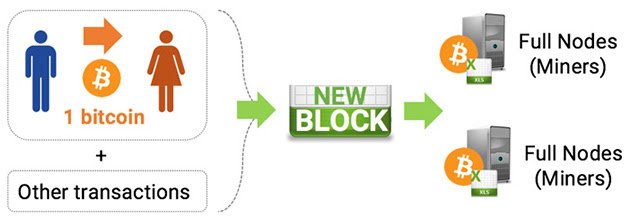
How does a miner get to add a block to the blockchain? This is where brute force mining comes into play.
Hashes, and how mining works
To understand this, we need to touch upon hashes.
A hash value is a series of numbers and letters strung together that looks something like this: 1gwv7fpx97hmavc6inruz36j5h2kfi803jnhg.
A hash value is generated by pushing data through a mathematical formula called a hash function.
Another way to think of this is like the ingredients for a smoothie and a blender.
You take your ingredients (your data), put it through a blender (the hash function) and you get your smoothie (the hash value).
Hashing is a one-way process. When you give me a hash value, I can’t turn it back into its original input data, in the same way I can’t turn my smoothie back into its original ingredients.
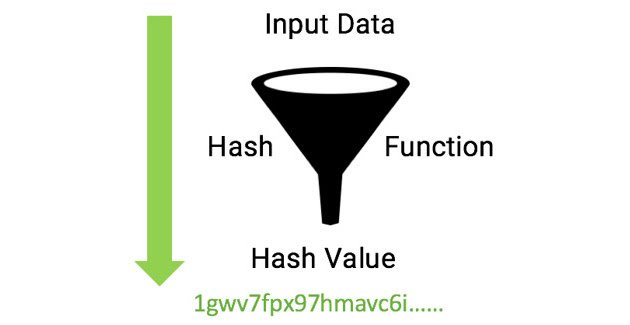
When miners are given a block of transactions to try and add to the blockchain, they are using a hash function to try and solve a cryptographic puzzle.
The miners take the new block with all the transactions in it, combine it with a randomly generated number string (called a nonce), put it through a hash function and then get a particular hash value.
What a miner is trying to do is find a hash value that starts with a specific number of 0s. They will keep trying different nonces until they get the necessary hash value.
This trial and error computation is shown in Step 1 and Step 2 in the diagram below.
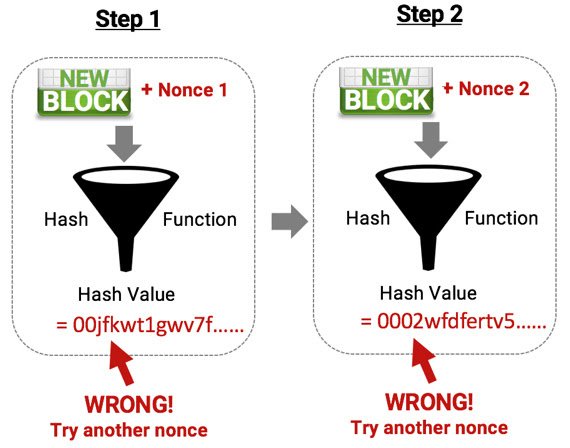
All the miners are in a race to find the correct hash value. This is because the miner who finds it (Step 3) will broadcast the correct solution to the network (Step 4), who will verify it is correct.
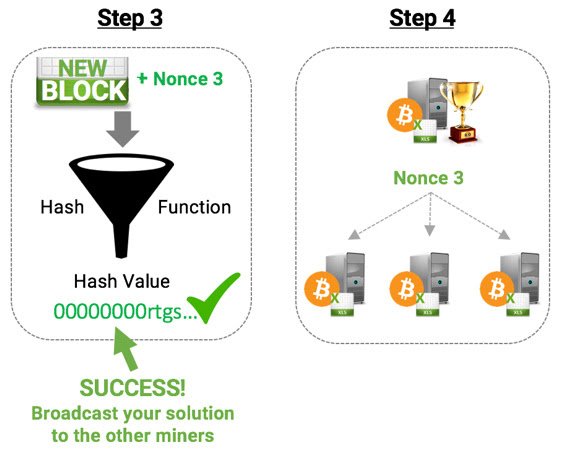
The new block then gets added to the blockchain (Step 5), and the winning miner gets awarded 12 bitcoin by the blockchain for his success. This is worth around US$55,000 in today’s prices.
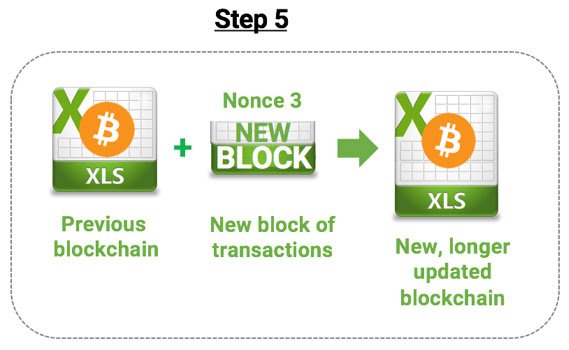
Sally’s bitcoin transaction is now recorded in the blockchain. Sally’s bitcoin wallet is now credited a bitcoin, and Jim’s is debited one.
The mining process then starts over again, with a whole new bunch of transactions bundled into a new block, and the miners all compete again to find the correct hash value.
Bitcoin is the “proof of concept”
In the media, bitcoin tends to hog the headlines when it comes to cryptocurrencies. But Bitcoin itself is just the proof of concept for blockchain. Bitcoin’s success has shown the world it is possible for independent and fragmented entities (miners) to enable strangers to exchange value with no need for an intermediary. And it can be done in a completely transparent, verifiable and open way.
As email is one use case for the Internet, so too is bitcoin a single use case for blockchain. There will be countless uses for blockchain in the future… from contracts that don’t require any intermediary to creating completely decentralised businesses built on blockchains. And there are countless opportunities for investors.
Good investing,
This post is very valuable @tranthienhanh. Explains with simple words what the blockchain is and how it works in a way that is understandable by anyone. I am sorry to see that such great post is so undervalued. Congratulations for your great work.
@digitalking, Thank you for beautiful words!!!
There is no principle worth the name if it is not wholly good.
- Mahatma Gandhi